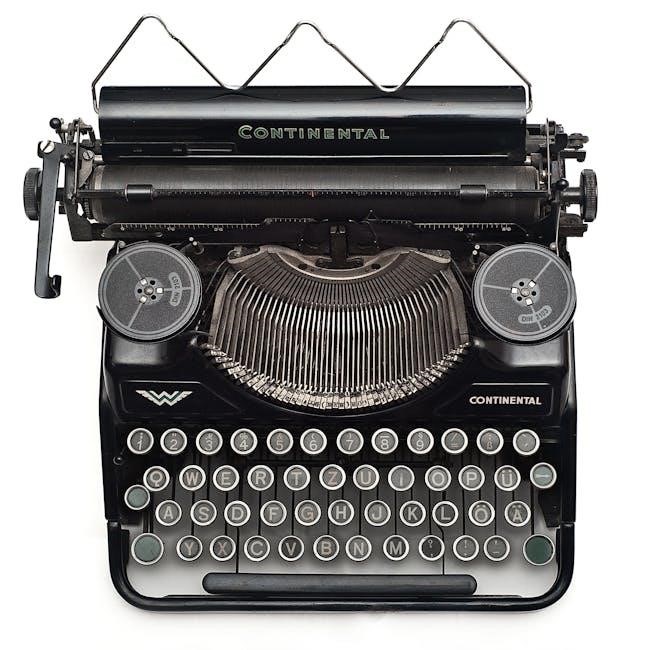Hills Manual of Social and Business Forms
This manual is a guide to correct writing, offering insights into expressing written thought plainly, rapidly, elegantly, and correctly. It covers various social and business practices from the 19th century.

Overview of the Manual
The manual provides comprehensive guidance on social etiquette, business forms, and correct writing techniques. It aims to equip readers with the knowledge to navigate social and professional situations effectively, according to the norms of its time.
Purpose and Scope of the Manual
The primary purpose of “Hills Manual of Social and Business Forms” is to serve as a comprehensive guide for individuals seeking to master the art of correct writing and navigate the complexities of 19th-century social and business interactions. Its scope encompasses a wide range of topics, including penmanship, spelling, punctuation, composition, and epistolary correspondence. The manual also delves into the intricacies of social etiquette, providing guidance on proper conduct in various social settings. Furthermore, it offers practical examples of commercial and legal forms, equipping readers with the necessary tools for business transactions and legal matters. The manual aims to empower individuals to communicate effectively and conduct themselves appropriately in both social and professional spheres, reflecting the standards and expectations of the era.
Target Audience
The “Hills Manual of Social and Business Forms” was primarily aimed at individuals in the late 19th century seeking to improve their communication skills and social graces. This included young adults entering the workforce, aspiring business professionals, and anyone desiring to enhance their social standing. The manual catered to those who wished to master correct writing, understand social etiquette, and navigate business transactions with confidence. It served as a practical guide for individuals seeking self-improvement and upward mobility in a society that placed a high value on proper decorum and effective communication. The book’s comprehensive nature made it accessible to a wide range of readers, from students to seasoned professionals, all striving to refine their social and business acumen.

Historical Context
Published in the late 19th century, the manual reflects Victorian-era social norms and business practices. It provides a glimpse into a time valuing etiquette, penmanship, and formal correspondence in society.
Thomas Edie Hill: Author and His Time
Thomas Edie Hill, the author, lived during a period of significant social and industrial change. His manual reflects the values and expectations of 19th-century society, emphasizing proper etiquette and effective communication. Hill’s work aimed to guide individuals in navigating the complexities of both social and business interactions. He sought to provide a comprehensive resource for achieving success through refined manners and skillful writing. The manual showcases the importance placed on clear and elegant expression, reflecting the educational standards and societal ideals of his time. Hill’s contributions offer valuable insights into the cultural landscape of the era, highlighting the significance of social graces and professional competence.
Publication Year and Editions
Hills Manual of Social and Business Forms was initially published in the late 19th century, with various editions released over the years. The manual’s publishing history reflects its popularity and enduring relevance as a guide to proper social conduct and business practices. Different editions may contain updated information or revisions to reflect changing societal norms. The manual’s continued publication indicates its value as a resource for individuals seeking to understand and adhere to established standards of communication and etiquette. Examining the different editions provides insights into the evolving expectations of social and professional life during that era, illustrating its lasting impact.

Content and Structure
The manual contains sections on writing principles, social etiquette, and business forms. It provides examples and instructions for various communication scenarios, offering a structured guide to proper conduct in social and professional settings.
Correct Writing Principles
The manual emphasizes clarity, rapidity, elegance, and correctness in written expression. It provides guidance on penmanship, spelling, and the proper use of capital letters. Punctuation is thoroughly addressed, ensuring readers understand its role in conveying meaning effectively. Composition techniques are explored, aiding individuals in constructing well-organized and coherent texts.
Furthermore, the manual delves into writing for the press and proofreading, equipping aspiring writers with essential skills for publication. Epistolary correspondence receives significant attention, covering various types of letters and their appropriate formats. Notes of invitation and cards are also discussed, reflecting the social customs of the time. By adhering to these principles, the manual aims to enhance communication skills.
Social Etiquette Guidelines
The manual provides thorough rules on social etiquette, reflecting 19th-century norms. It offers guidance on approved methods in speaking and acting in various social situations. The proper way to dress for different occasions is outlined, emphasizing appropriateness and decorum. Instructions are included on arranging flowers to convey specific messages, showcasing the symbolic language of the era.
Furthermore, the text details acceptable behavior during social interactions, including interactions with acquaintances and strangers. The importance of grace and favor in social exchanges is highlighted. The manual also contains insights into navigating complex social relationships and expectations, offering a glimpse into the values and customs of the time, aiding understanding of historical social dynamics.
Business Forms and Practices
The manual delves into commercial forms and legal business practices prevalent in the 19th century. It offers detailed instructions on drafting various business documents, including advertisements and contracts. Examples of acceptable business correspondence are provided, emphasizing clarity and professionalism. The text includes guidance on financial matters, such as writing checks and understanding currency conversions.
Furthermore, the manual covers topics like executing agreements and handling estates, offering insights into the legal framework of the time; It provides valuable information on business etiquette and ethical conduct. The content reflects the business norms and standards of the era, aiding in understanding historical commercial interactions. Guidance on topics such as bankruptcy and exemptions are also covered.
Key Topics Covered
The manual extensively covers penmanship, spelling, epistolary correspondence, and legal/commercial forms. These topics showcase proper communication, essential for social and business interactions during the 19th century.
Penmanship and Spelling
Within “Hills Manual of Social and Business Forms,” meticulous attention is given to penmanship, reflecting its importance in 19th-century communication. Clear, legible handwriting was viewed as a marker of education and refinement. The manual likely provides detailed instructions and examples to improve handwriting skills. Proper spelling was equally crucial, ensuring clarity and professionalism in written correspondence. The manual includes guidance on correct spelling, usage, and potential pitfalls. Exercises and examples would have aided readers in mastering these fundamental skills. Mastering penmanship and spelling ensured effective communication in both social and business contexts. The manual aimed to equip individuals with tools to express themselves eloquently and accurately.
Epistolary Correspondence
A significant portion of “Hills Manual” addresses epistolary correspondence, a vital aspect of social and business interaction in the 19th century. The manual offers guidance on crafting various types of letters, from formal business communications to personal notes of invitation. Proper etiquette in letter writing, including salutations, closings, and tone, receives detailed attention. Examples of model letters for different occasions provide practical templates. The manual likely covers the appropriate use of language, grammar, and style to convey the intended message effectively. It also includes instruction on addressing envelopes and folding letters correctly. Mastering these skills was essential for maintaining social standing and conducting business professionally. The manual provides a comprehensive guide to the art of letter writing.
Legal and Commercial Forms
“Hills Manual” includes a section on legal and commercial forms, reflecting the era’s business practices. This segment provides templates and instructions for drafting essential documents, such as contracts, receipts, and promissory notes. The manual explains the proper format and language for these forms, ensuring clarity and legal validity. It likely covers various aspects of commercial transactions, including sales, purchases, and debt management. Understanding these forms was crucial for business owners and individuals alike. The manual might also touch upon basic legal principles relevant to everyday transactions. This section aims to equip readers with the knowledge to navigate the legal and commercial landscape confidently. It serves as a practical guide to formalizing agreements and conducting business affairs according to established norms and legal standards of the time, offering crucial insights into 19th-century practices.

Relevance and Legacy
“Hills Manual” offers valuable insights into 19th-century social norms and business practices. It remains useful for historical research, providing a glimpse into the past. The manual’s availability allows access for continued study.
Insight into 19th-Century Social Norms
The “Hills Manual of Social and Business Forms” serves as a fascinating window into the social expectations and customs prevalent during the 19th century. Examining the manual reveals the intricate rules governing etiquette, correspondence, and interpersonal interactions of the time. It illustrates a society deeply concerned with propriety, decorum, and adherence to established social hierarchies.
The detailed instructions on everything from penmanship to appropriate dress offer valuable clues about the values and beliefs that shaped social behavior. By studying these guidelines, researchers and enthusiasts can gain a deeper understanding of the nuances of 19th-century life and the importance placed on maintaining social order and respectability. The manual preserves details of a bygone era.
Usefulness for Historical Research
The “Hills Manual of Social and Business Forms” provides a valuable resource for historical research, offering primary source material on 19th-century social and business practices. Its comprehensive coverage of topics such as etiquette, correspondence, and legal forms provides researchers with detailed insights into the daily lives and expectations of people during that era.
Historians can utilize the manual to study the evolution of social norms, communication styles, and business practices. The specific examples and instructions within the manual offer tangible evidence of the values, beliefs, and customs that shaped 19th-century society. It is a window into understanding the nuances and complexities of life in the past. The book aids academic study.
Availability and Accessing the Manual
The “Hills Manual of Social and Business Forms” is accessible through various avenues, making it available to researchers and interested individuals. Many libraries and historical societies hold physical copies of the manual, particularly older editions, which can be consulted for research purposes. Digitized versions are also available online through platforms like Google Books and Internet Archive, offering convenient access for those unable to visit physical archives.
Furthermore, reprints and modern editions may be available for purchase through online retailers such as Amazon and other booksellers. These reprints can be a cost-effective way to acquire a personal copy for study or reference. Checking with university libraries is also advised. The manual helps with research.

